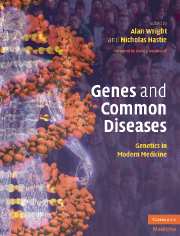Book contents
- Frontmatter
- Contents
- List of Contributors
- Foreword
- Section 1 Introductory Principles
- Section 2 Common Medical Disorders
- 13 Developmental disorders
- 14 Genes, environment and cancer
- 15 The polygenic basis of breast cancer
- 16 TP53: A master gene in normal and tumor suppression
- 17 Genetics of colorectal cancer
- 18 Genetics of autoimmune disease
- 19 Susceptibility to infectious diseases
- 20 Inflammatory bowel diseases
- 21 Genetic anemias
- 22 Genetics of chronic disease: obesity
- 23 Type 2 diabetes mellitus
- 24 Genetics of coronary heart disease
- 25 Genetics of hypertension
- 26 Obstructive pulmonary disease
- 27 Skeletal disorders
- 28 The genetics of common skin diseases
- 29 Molecular genetics of Alzheimer's disease and other adult-onset dementias
- 30 Major psychiatric disorders in adult life
- 31 Speech and language disorders
- 32 Common forms of visual handicap
- 33 Genetic and environmental influences on hearing impairment
- 34 Pharmacogenomics: clinical applications
- Index
- References
17 - Genetics of colorectal cancer
Published online by Cambridge University Press: 17 August 2009
- Frontmatter
- Contents
- List of Contributors
- Foreword
- Section 1 Introductory Principles
- Section 2 Common Medical Disorders
- 13 Developmental disorders
- 14 Genes, environment and cancer
- 15 The polygenic basis of breast cancer
- 16 TP53: A master gene in normal and tumor suppression
- 17 Genetics of colorectal cancer
- 18 Genetics of autoimmune disease
- 19 Susceptibility to infectious diseases
- 20 Inflammatory bowel diseases
- 21 Genetic anemias
- 22 Genetics of chronic disease: obesity
- 23 Type 2 diabetes mellitus
- 24 Genetics of coronary heart disease
- 25 Genetics of hypertension
- 26 Obstructive pulmonary disease
- 27 Skeletal disorders
- 28 The genetics of common skin diseases
- 29 Molecular genetics of Alzheimer's disease and other adult-onset dementias
- 30 Major psychiatric disorders in adult life
- 31 Speech and language disorders
- 32 Common forms of visual handicap
- 33 Genetic and environmental influences on hearing impairment
- 34 Pharmacogenomics: clinical applications
- Index
- References
Summary
Introduction
Colorectal cancer is a major public health problem in the developed world and is becoming increasingly prevalent in developing countries. The current annual world incidence is around 950 000 cases (Globocan, 2000). It is the most common cause of early cancer death in the non-smoking population. Recent developments have led to the isolation of a number of moderate- to high-risk cancer susceptibility genes for the disease. Identifying people with high-risk alleles offers real opportunities for application of preventive measures. Intensive surveillance to detect early cancer, or even prevent cancer by polyp removal, can be targeted by genotype information. Surgical intervention and chemoprevention guided by genetic information are also likely to be part of future armaments used to combat the disease. The last ten years has seen a number of exciting developments in understanding key molecular events involved in colorectal cancer susceptibility, which are beginning to provide new insight into the fundamental basis of the disease. In this chapter we will describe the major advances and how they are impacting diagnosis and clinical management of colorectal cancer.
Colorectal cancer epidemiology
The multifactorial etiology of colorectal cancer involves environmental factors as well as genetic susceptibility (see Chapter 14). There are large differences in global prevalence of the disease, which is generally four times higher in developed countries than in developing countries (IARC, WHO, 1997). Incidence rates also vary according to ethnicity (American Cancer Society, 2002), however the observed variation between countries is primarily due to the role of environmental factors.
- Type
- Chapter
- Information
- Genes and Common DiseasesGenetics in Modern Medicine, pp. 245 - 267Publisher: Cambridge University PressPrint publication year: 2007



